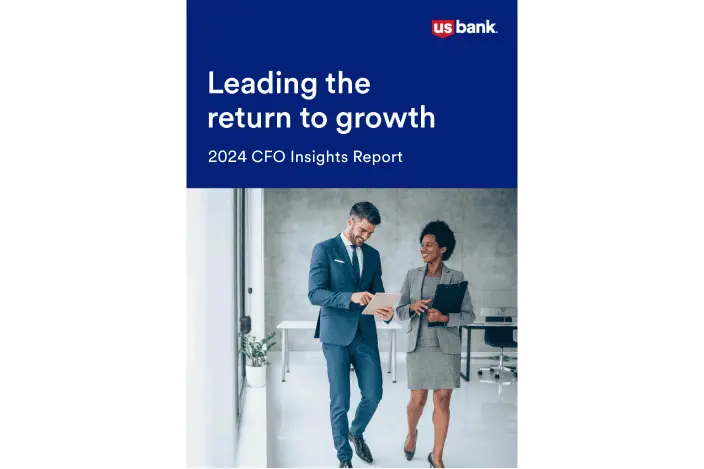A strong appetite for digital transformation
Digital transformation has huge potential for streamlining and speeding up businesses’ financial processes. Yet as new U.S. Bank research suggests, many finance executives feel they’ve only scratched the surface – leaving them eager to do more to capture its full benefits
Our survey of 2,030 finance executives confirms that the number one priority for the finance function in 2024 is cutting costs and driving efficiencies, a goal that 44% of those surveyed identify. Of those executives, nearly half (47%) say technology will be the key to achieving these efficiencies.
Yet the picture of digital adoption that emerges from our report is patchy. Overall, 46% of finance leaders tell us their finance functions are still in the early stages of digital transformation.
44% of survey respondents cite cost-cutting and driving efficiencies as the top priority.
46% of survey respondents say their finance functions are in the early stages of digital transformation.
Finance executives want more from digital transformation
In our survey, we asked finance executives to indicate on a scale from one to 10 how satisfied they are with their progress on digital transformation:
- 20% are satisfied, scoring 8‒10.
- 27% are unsatisfied, scoring just 1‒4.
- 53% are in the middle, scoring 5‒7.
“The fact that only one in five finance executives is satisfied with their progress shows that most finance leaders have the right mindset to go further with digital technology,” points out Dominic Venturo, CDO and Senior Executive Vice President at U.S. Bank.
Yet those leaders face challenges. The CFO may be the second seat at the table in the C-suite, says Venturo, but the wider business often still regards finance as a back-office function – and when it comes to allocating budget, companies tend to prioritize customer-facing areas where investment can yield incremental revenue growth.
In fact, the most common barrier to progress when it comes to digital finance is a lack of enterprise-wide strategies for digital transformation, as highlighted by 36% of survey respondents. Undoubtedly, if the entity as a whole isn’t focusing on digital, it is much harder for finance executives to justify digital transformation initiatives in their own function.
Conversely, when digital is core to the overarching strategy, digital opportunities come to the forefront across the company. It becomes easier to make the case for change initiatives, whether to achieve process efficiencies, to better manage the company’s cash, or to support wider strategic priorities such as improving customer experience and retention.
“By using the solutions that have been developed by banks and other technology providers, finance leaders may find they can move faster than they expect.”
Dominic Venturo, Chief Digital Officer and Senior EVP, U.S. Bank
How to accelerate progress in the finance function
For CFOs looking to make faster progress on digital, there are two key factors to consider.
First, they should ensure that finance builds on its initial investments in digital platforms by maximizing its contribution to subsequent digital transformation projects across the organization. If digital marketing or customer teams are working on customer experience, for example, finance should ensure they have digital payment systems in place. (Our survey shows that finance leaders understand this link. Improving the customer and vendor payment experiences is a top-three priority within their digital transformation plans for the coming year, with 79% of respondents ranking it as important.)
Once finance has taken the first steps to building new digital capabilities, it can contribute more meaningfully to other initiatives. These include harnessing more effectively the finance technology solutions it has already implemented and sharing learnings. This will position the finance function as a key player in digital transformation.
The second key point for finance leaders to consider is that the barriers to digital transformation in the finance function are lower than ever.
For example, companies can transform their payments or data-feed capabilities by using the application programming interfaces (APIs) developed by banks, which can be integrated easily with existing enterprise resource planning (ERP) systems. For previously tricky-to-meet processing requirements, the likelihood is that there is now a tool that can do the job off the shelf.
“By using the solutions that have been developed by banks and other technology providers, finance leaders may find they can move faster than they expect,” says Venturo.
Tap into existing talent to drive transformation
The second most common barrier to digital transformation that financial leaders in our survey identify is a lack of skills or personnel to implement and use new technology effectively (34%).
Often, rather than a talent issue, this proves to be related to talent management. When leaders commit to transformation, they frequently discover that their people have valuable skills and knowledge that were previously hidden.
Of course, not everyone is a technology specialist-in-waiting. But those who understand their firms’ processes and how to improve them have a major role to play. This can be maximized by drawing in specific skills and experience from other parts of the organization, creating a dialogue between people who know how their function works and those who can help build solutions.
By building project teams within the organization, companies develop an internal ecosystem of digital talent and learning. It is a far better option than hiring specialists who just work on the immediate problem then move on.
AI is the new business frontier
What about the role of AI for finance teams? AI is already highly capable of meeting many common requirements. When a company receives an invoice, for example, AI can match it to the vendor contract, ensure it’s within budget and the parameters of the contract, and check it meets policy requirements. Companies may prefer to retain human oversight of this process for the time being but a future where AI manages this exclusively is not far away.
“AI can be very useful in multiple areas, from pre-coding invoices to assisting with caregiver performance evaluations,” says Greg Hoffman, EVP and CFO at Providence, a not-for-profit Catholic healthcare system that operates across seven states. “Used correctly, it can cut a lot of administrative tasks, so that our clinicians can focus on direct patient care.”
In the medium term, generative AI and large language models (LLMs) are sure to unlock many new ways of working. For instance, generative AI can become an authoritative source of guidance on budgets or other finance-related questions. Provide an AI with the company’s policies, procedures and guidelines, and it can formulate answers instantly. That could have major efficiency benefits.
Then, there are the more advanced use cases for AI, such as capital or cash flow forecasting, where data scientists have built sophisticated models for scenario planning. Take the example of planning for supply chain disruption. Some large companies are building virtual twins that model their supply chains in incredible detail, enabling them to simulate potential disruptions. Think of the Suez Canal closure, or the recent tragic collapse of the Baltimore bridge. This type of work is high-impact and high-value and could revolutionize how the finance function fulfils its responsibilities around risk management.
But all these use cases require finance to have put in place the core elements of digital transformation. If the finance function has neglected to create a central data store and establish the right workflow processes, the company may not be able to unlock these gains.
Redesigning processes is the first step to acceleration
For those CFOs still in the early stages of digital transformation – or who are embarking on a new phase of AI adoption – again, there are two critical points to bear in mind, points out Venturo.
First, it’s critical not to simply take the existing process and try to digitize it. “Map out every task within that process and evaluate which need to stay and which can go,” advises Venturo. Of those marked for retention, teams should identify which can be automated, and move forward with those. “Without redesigning and improving their processes, organizations cannot deliver the hoped-for value from digital transformation,” he adds.
The second point is critical to developing momentum to achieve change. “Whether it’s digital transformation or implementing AI and machine learning, the most important thing a leader can do to get started is to do something,” says Venturo. Leaders often allow the barriers to wholesale transformation impede smaller-scale change projects, such as improving an inefficient function, which could deliver useful results and begin to build capabilities for more ambitious projects that will accelerate progress over the year ahead.
More Resources
Stay Connected
Read the full 2024 CFO Insights Report
Digital transformation is one of many topics covered in this year’s CFO Insights Report. The full report dives deep into the multiple ways finance leaders are guiding their companies through today’s unique economic and geopolitical environments. With responses from more than 2,000 finance leaders, the report is sure to provide valuable insights to inform your own decisions.
More insights from our research
California report
What are California’s finance leaders focused on?
Payments Insights
What is driving payments transformation?
Economy
How are finance leaders viewing the economy?
Healthcare Report






